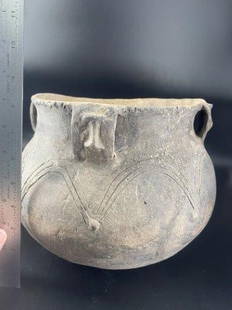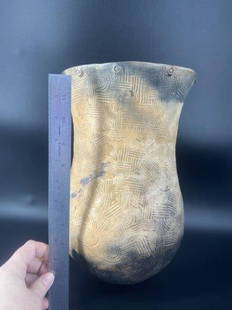
UNIDENTIFIED HAIDA ARTIST, Bent Corner Bowl, c. 1800-1825
Similar Sale History
View More Items in Tribal & Native American Artifacts

Related Tribal & Native American Artifacts
More Items in Tribal & Native American Artifacts
View MoreRecommended Art
View More







Item Details
Description
UNIDENTIFIED HAIDA ARTIST
Bent Corner Bowl, c. 1800-1825
carved and stained cedar wood, 3.5 x 6.25 x 5.25 in (8.9 x 15.9 x 13.3 cm)
Provenance
Private Collection, Seattle, WA;
A New York Collection.
Published
Donald Ellis Gallery Catalogue, 2003, p. 6Bent-corner bowls are perhaps the epitome of the wood bender’s art on the Northwest Coast, and this one is a superb example. The sides are made from a plank of wood thick enough to accommodate the bulging side surfaces and the extreme width of the thinly carved rim. The bulge of the sides is carved into the plank and hollowed out before steaming and bending. Some such bowls have an even more exaggerated bulge to the sides, which appear almost round when viewed from above. The bulges are a visual metaphor for the abundance the owner is able to serve within at feasts and potlatches. With the fourth corner fastened by sewing, more common in older examples, or pegging, the sides are attached to the bottom by one or another of the same methods. In this bowl, the fourth corner and the bottom attachment have been sewn. The design work on this bowl is made up of four different formline patterns, with no two sides being the same. Often on bowls of this kind the ends are designed to represent the head and tail of a creature, with the two sides depicting body, wings, or limbs as appropriate, being either the same or nearly so, only differing in minor details. In this bowl, the ends both exhibit symmetrical formline designs, though it is not possible to readily assign head or tail identities to either one; they just aren’t that specific. The two sides each display asymmetrical formlines, and each is totally different from the other. The artist’s work exhibits a mastery of the formline tradition, with inventive compositions made up of powerful forms deeply relief carved. The weight of the formlines, a measure of their relative width, and the structure of the formline pattern and secondary design areas suggest that the bowl was made in the first quarter of the nineteenth century.
Steven C. Brown
References: For a similar Tlingit example see Steven C. Brown, Native Visions: Evolution in Northwest Coast Art from the Eighteenth Through the Twentieth Century, (Seattle: University of Washington Press, 1998), pl. 3.8; for a later Tsimshian example see pl. 4.34. For roughly contemporaneous Tsimshian, Haida and Tlingit examples at UBC MOA see Karen Duffek, Bill McLennan and Jordan Wilson, Where the Power Is: Indigenous Perspectives on Northwest Coast Art, (Vancouver: Figure 1 Publishing / Museum of Anthropology at UBC, 2021), pp. 236-237, pp. 292-293, and pp. 315-317 respectively. See also William Sturtevant ed., Boxes and Bowls: Decorated Containers by Nineteenth Century Haida, Tlingit, Bella Bella, and Tsimshian Indian Artists, (Washington, DC: Smithsonian Institution Press, 1974), figs. 48-65.
Bent Corner Bowl, c. 1800-1825
carved and stained cedar wood, 3.5 x 6.25 x 5.25 in (8.9 x 15.9 x 13.3 cm)
Provenance
Private Collection, Seattle, WA;
A New York Collection.
Published
Donald Ellis Gallery Catalogue, 2003, p. 6Bent-corner bowls are perhaps the epitome of the wood bender’s art on the Northwest Coast, and this one is a superb example. The sides are made from a plank of wood thick enough to accommodate the bulging side surfaces and the extreme width of the thinly carved rim. The bulge of the sides is carved into the plank and hollowed out before steaming and bending. Some such bowls have an even more exaggerated bulge to the sides, which appear almost round when viewed from above. The bulges are a visual metaphor for the abundance the owner is able to serve within at feasts and potlatches. With the fourth corner fastened by sewing, more common in older examples, or pegging, the sides are attached to the bottom by one or another of the same methods. In this bowl, the fourth corner and the bottom attachment have been sewn. The design work on this bowl is made up of four different formline patterns, with no two sides being the same. Often on bowls of this kind the ends are designed to represent the head and tail of a creature, with the two sides depicting body, wings, or limbs as appropriate, being either the same or nearly so, only differing in minor details. In this bowl, the ends both exhibit symmetrical formline designs, though it is not possible to readily assign head or tail identities to either one; they just aren’t that specific. The two sides each display asymmetrical formlines, and each is totally different from the other. The artist’s work exhibits a mastery of the formline tradition, with inventive compositions made up of powerful forms deeply relief carved. The weight of the formlines, a measure of their relative width, and the structure of the formline pattern and secondary design areas suggest that the bowl was made in the first quarter of the nineteenth century.
Steven C. Brown
References: For a similar Tlingit example see Steven C. Brown, Native Visions: Evolution in Northwest Coast Art from the Eighteenth Through the Twentieth Century, (Seattle: University of Washington Press, 1998), pl. 3.8; for a later Tsimshian example see pl. 4.34. For roughly contemporaneous Tsimshian, Haida and Tlingit examples at UBC MOA see Karen Duffek, Bill McLennan and Jordan Wilson, Where the Power Is: Indigenous Perspectives on Northwest Coast Art, (Vancouver: Figure 1 Publishing / Museum of Anthropology at UBC, 2021), pp. 236-237, pp. 292-293, and pp. 315-317 respectively. See also William Sturtevant ed., Boxes and Bowls: Decorated Containers by Nineteenth Century Haida, Tlingit, Bella Bella, and Tsimshian Indian Artists, (Washington, DC: Smithsonian Institution Press, 1974), figs. 48-65.
Condition
The absence of condition does not imply that an item is free from defects, nor does a reference to particular defects imply the absence of any others. Our team can provide thorough and comprehensive condition reports and additional images. We welcome your enquiries at info@firstarts.ca or 647-286-5012.
NOTE
Many countries prohibit or restrict importation or exportation of property containing ivory, whale bone, sealskin, and/or products derived from other endangered or protected species, and require special licenses or permits in order to import or export such property. It is the responsibility of the buyer to ensure that the item is properly and lawfully exported / imported.
NOTE
Many countries prohibit or restrict importation or exportation of property containing ivory, whale bone, sealskin, and/or products derived from other endangered or protected species, and require special licenses or permits in order to import or export such property. It is the responsibility of the buyer to ensure that the item is properly and lawfully exported / imported.
Buyer's Premium
- 23%
UNIDENTIFIED HAIDA ARTIST, Bent Corner Bowl, c. 1800-1825
Estimate CA$40,000 - CA$60,000
15 bidders are watching this item.
Get approved to bid.
Shipping & Pickup Options
Item located in Toronto, Ontario, caSee Policy for Shipping
Local Pickup Available
Payment

TOP
















































































